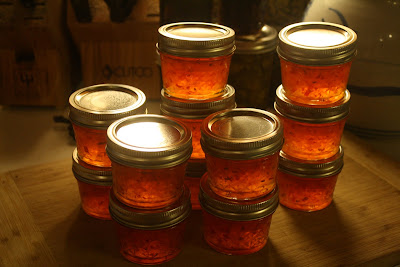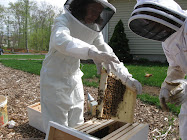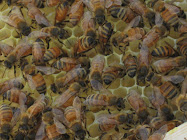Last Friday was my big moment . . . I had the opportunity to go to a friends house (and fellow bee keeper with 6 hives) to use her extractor just before she extracted honey from 8 honey supers (x10 frames each = 80 frames of honey!) As you would expect, I brought along my camera to document the momentous event . . .
Here is the inside of her very nice electric extractor. A lot of extractors are of the cranking variety - which is a lot better than no extractor. But the electric one sure was nice!

First, you have to remove the wax capping that the bees build on top of each cell filled with aged honey. This was a very small splash of honey on one particular frame, but it's a great picture of removing the cappings. You slide the angled metal comb just under the cappings, lift it off, and dump the gooey piece of wax into a bucket.

Here is my friend Diane helping me with my frames.
Using this comb like cappings remover is slow business, but it generally damages the comb that the bees build the least. There are heated knives and slicer things that you can use, but they cut into the comb more than this small hand-held number.

And, here I am!

Diane had everything set up nicely. As a bee keeper in her 5th year, she has gotten this project down to a science. The plastic sheeting was a great idea. She also put some pieces of cardboard down on the ground between the table and the extractor to catch drips. If you don't put some effort into creating a good system, I could see how this would be a HUGE mess! As is was, it was pretty dern sticky!

Here are all of my frames sitting in the extractor. The extractor spins at a high speed, pulling out the honey using centrifugal force. Then, the honey drips down the sides and out through a spigot.


Diane tipped the extractor when it was done spinning to get all of the honey to pour out of the spigot and into my bucket. I used a strainer this year, but next year I may try making the raw honey that is not strained -- and then is creamed in some way. At least I'll try to do some that way. That honey is supposed to be even better for you.

Look at all of that honey! When it was all said and done, I ended up with about 1/3 of a 5 gallon bucket worth of honey. This will have to last me through July of next year. With all of the baking I do with honey, my granola, yogurt and tea I will probably end up buying some in the end. But, my harvest wasn't bad considering I had two swarms this year!











































